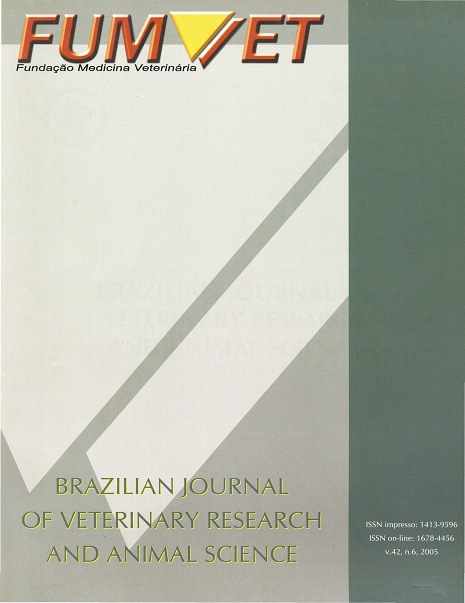Gross aspects of macro and microvascularization of sheep placenta (Ovis aries)
DOI:
https://doi.org/10.11606/issn.1678-4456.bjvras.2005.26398Keywords:
Placenta, Microvasculartization, SheepAbstract
Placenta possesses various essential independent vascular systems and intimately associated vascular systems, the effectiveness of which are related to the type of blood stream between the maternal and fetal circulation and, therefore, the morphology of the vascularization. The aim of this research was to study the anatomical aspects of gross and microscopic vascularization of the sheep placenta (Corriedale cross breeds and Ideal breeds, living at sea level) and the systematization of the fetal vessels from umbilical funiculus until the capillary bed. The cotyledons were demonstrated to be mostly spheroids and to possess between one to four vascular in the majority and receive from one to four vascular branches in their central concavity. Anastomoses of the umbilical funiculus vessels occur only between arteries and anastomoses between the chorionic vessel branches are more frequent in veins than in the arteries.Were found 187 types of different cotyledonary-artery arrays were found. The chorionic artery leading to pregnant horn is shorter in lenght and emits fewer cotyledonary branches than the non pregnant horn. The chorionic vein is formed by the confluence of two branches and receives collateral tributary vessels that frequently are anastomosed between themselves. The microvascularization of the fetal cotyledon was studied by scanning electron microscopy and is demonstrated to possess of cylindrical villous trees with vessels and with parallel vessels and with capilarization in the villous extremities. Capillary fan-like handles and conical villous trees are also observed. The macrocospic features of the cotyledons and microscopy of the villous trees reflect the altitude in which the animals live (the 95 m above sea level).Downloads
Download data is not yet available.
Downloads
Published
2005-12-01
Issue
Section
UNDEFINIED
License
The journal content is authorized under the Creative Commons BY-NC-SA license (summary of the license: https://
How to Cite
1.
Schoenau LSF, Pinto L de M, Pereira FTV, Schoenau W, Miglino MA. Gross aspects of macro and microvascularization of sheep placenta (Ovis aries). Braz. J. Vet. Res. Anim. Sci. [Internet]. 2005 Dec. 1 [cited 2024 Jul. 26];42(6):405-13. Available from: https://www.revistas.usp.br/bjvras/article/view/26398





